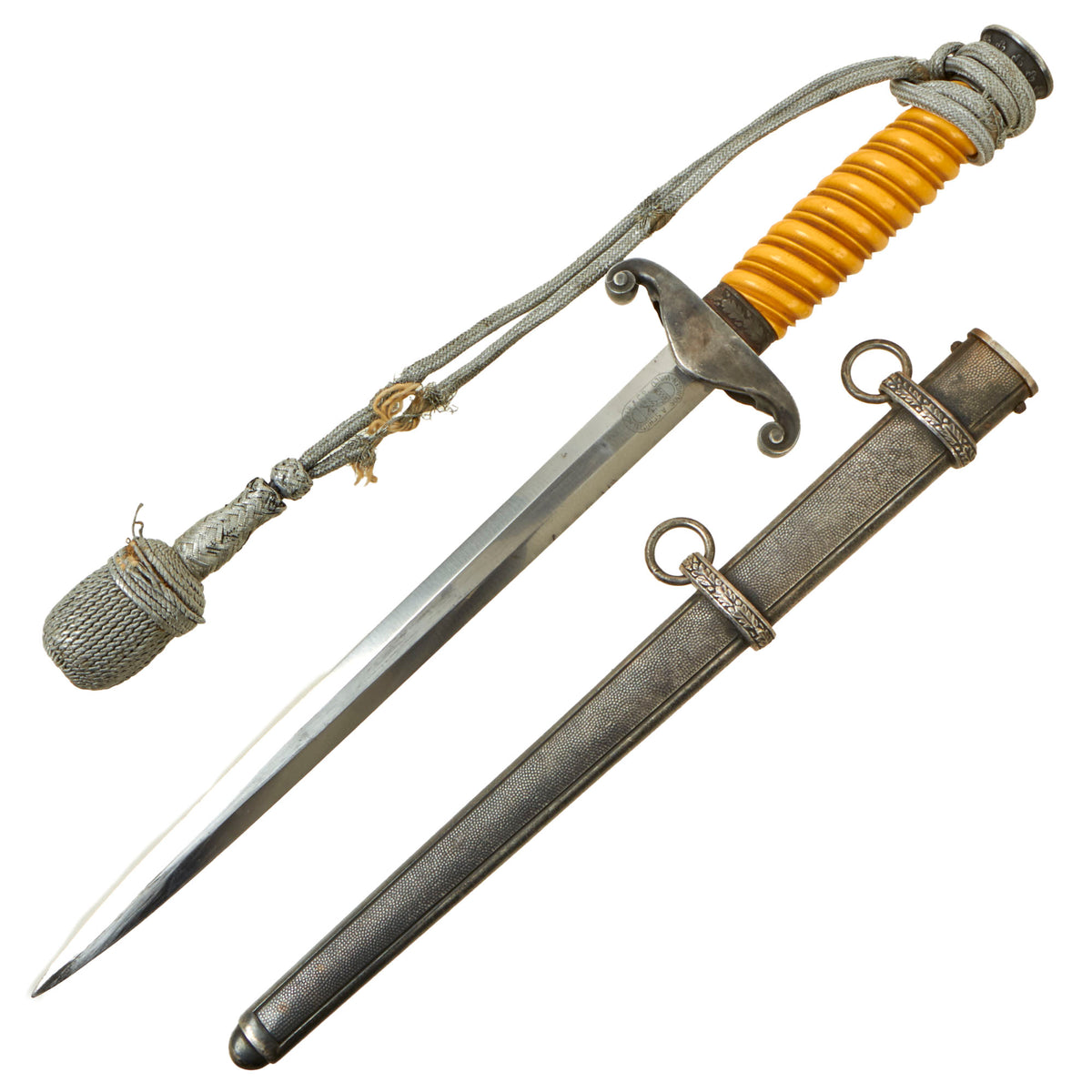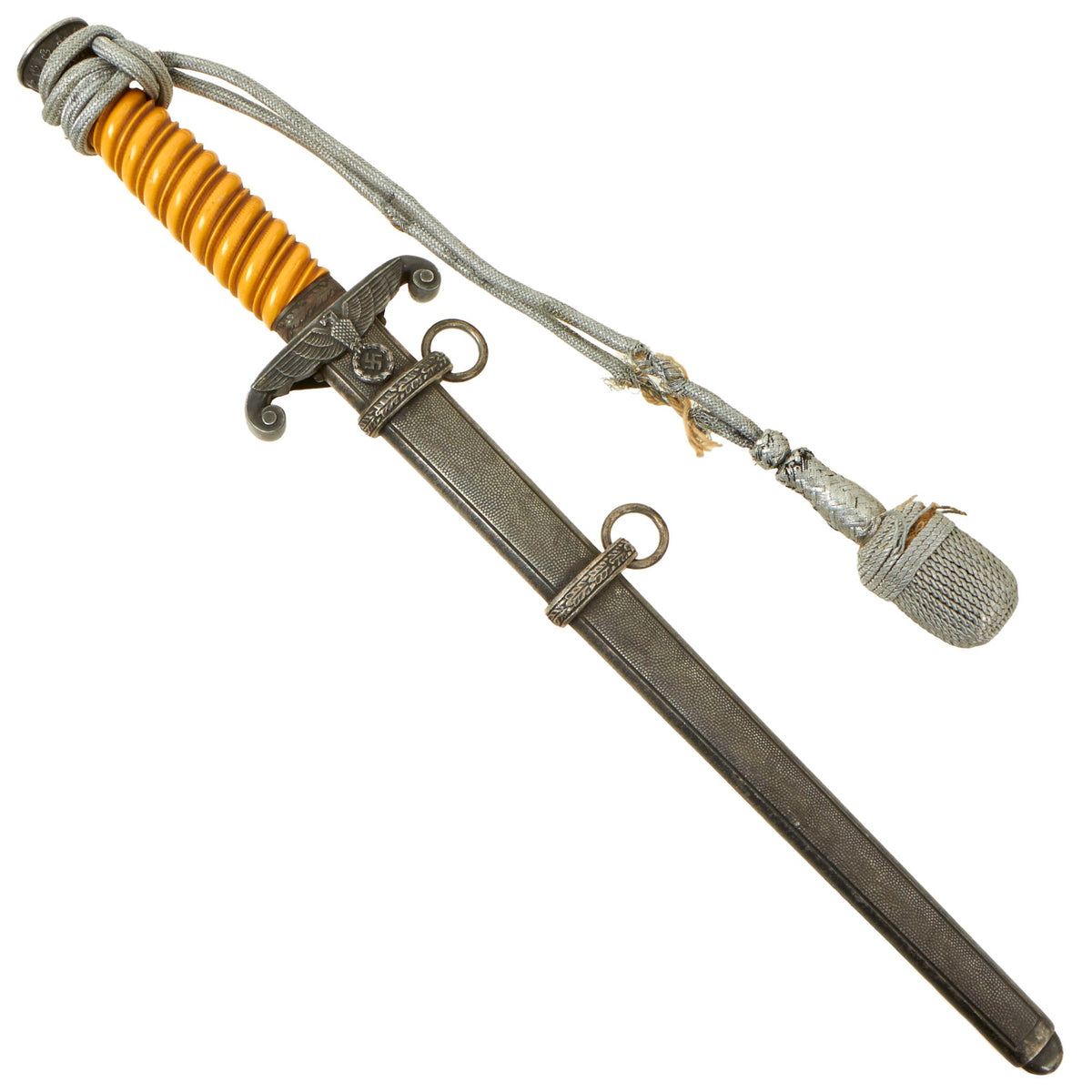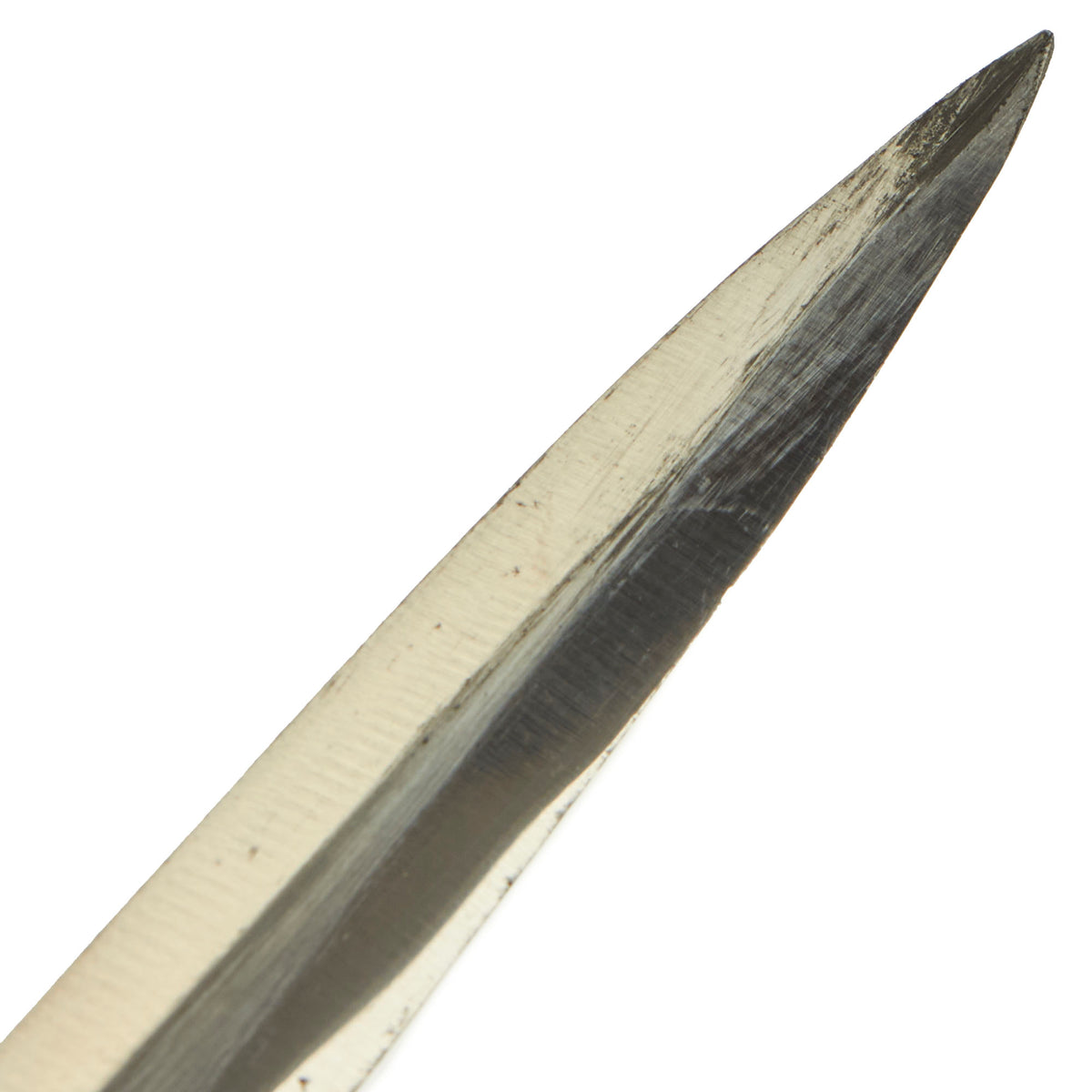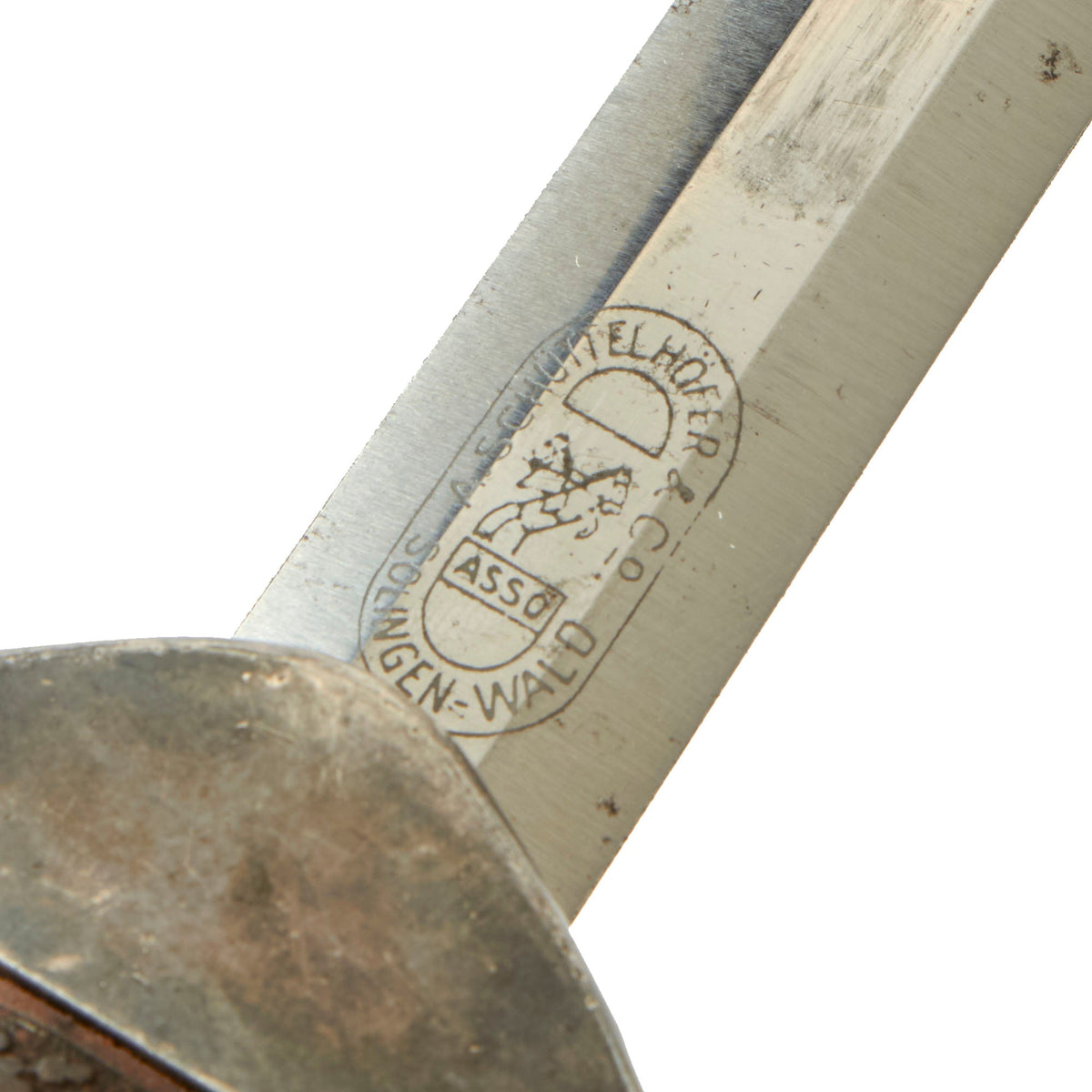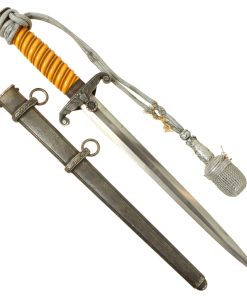Original German WWII Early Army Heer Officer Dagger by Rare Maker Artur Schüttelhöfer & Co. with Scabbard and Portepee Original Items
$ 895,00 $ 223,75
Original Item: Only One Available. This is a very good condition Army Officer’s Dagger, produced by the rare Solingen-based firm Artur Schüttelhöfer & Co, complete with its original scabbard and portepee knot. The alloy pommel of this dagger is in very good condition, showing light wear around the bottom edge. It looks to have been plated and then oxide coated, giving it a lovely deep blue color overall. It may be that it is made from a solid alloy like Tombak or Nickel Silver, and then oxide coated. The standing oak leaves and acorns are crisply detailed around the pommel, and there is little wear or damage of any kind, except around the edge, the first place to wear.
The crossguard looks to be made in the same way, with a blue oxide coating overall, which is very well retained. It does show some wear through on the raised areas, but for the most part looks great. There is a bit of oxidation on the ends of the “scrolls” at the edges. The details throughout the characteristic eagle are exceptional throughout the head, breast and wing feathering, talons and wreathed mobile swas. The grip ferrule looks to be plated steel, and had the same blue oxide coating, however it now shows an oxidized patina overall. The celluloid grip has faded to a lovely aged ivory color, showing just a bit of wear and staining, and no damage we can see.
Wrapped around the pommel end grip and cross guard is an original aluminum bullion thread portepee (sword knot), which is not the correct heer fashion, but we have left as is. It shows some wear and fraying, as well as some bullion loss in one area, which is now in somewhat delicate condition.
The blade on this example is in very good condition, with the factory final polish grind cross grain present throughout the blade, with some fading from runner wear and cleaning. This texture is iconic, and is the definitive identifying characteristic for a real WWII German Blade. There is very little oxidation or staining, and the edge is correctly not sharpened. There is however a bit of a bend about 1/2″ from the tip, which we have left intact to preserve the history.
The reverse of the blade is faintly marked with the oval “cartouche” marking of Artur Schüttelhöfer & Co., which encompasses the address, brand name, and even the “Two Hobby Horses in Saltire” trademark:
A. SCHÜTTELHÖFER & Co.
(Trademark)
ASSO
SOLINGEN-WALD
Artur Schüttelhöfer & Co. Stahlwarenfabrik (Steelware factory) was based in the Wald neighborhood of Solingen, the legendary “City of Blades” in Western Germany. This company was founded in 1920, and assembled and finished daggers for political organizations and officers during the Third Reich period, per J. Anthony Carter’s excellent book GERMAN KNIFE AND SWORD MAKERS. They manufactured SA, NSKK, and SS daggers, among other items. The “rectangular” trademark logo was only seen on a very few SS daggers, in addition to a few Army Officer’s and 2nd Model Luftwaffe Officer’s daggers. The original leather blade buffer is in place within the deep recesses of the guard, though it is a bit degraded.
The scabbard is a fine example, and is made of high quality plated steel, which then had the same blue oxide coating applied as on the other fittings. There are no large dents or bends that we can see, and the plating is still well retained, though it has bubbled a bit in places. This scabbard has very crisp, finely pebble grained panels, and the aluminum carrying bands have a very nice overlapping oak and acorn motif, a common design seen on German edged weapons. The throat is the thinner style, and has two “dome head” screws on the narrow sides of the scabbard.
A lovely example from a very rare Solingen maker, complete with its original scabbard and portepee. Ready to display!
Specifications:
Blade Length: 10″
Blade Style: Spear Point Dagger
Overall length: 14 3/4“
Crossguard: 2 3/4”
Scabbard Length: 11″
The German Army (Heer) first carried a dagger beginning in 1935. The weapon was worn in lieu of occasions not demanding the wearing of a more formal sword. The dagger design was quite attractive featuring silvered heavy fittings with white or colored grip. The crossguard depicted a Wehrmacht open-winged eagle clutching a wreathed swas.
The pommel depicted oak leafing around the outer circumference. The scabbard had panels of pebble designs. Later produced examples were plated with nickel, and late war-made pieces were unplated, finished in a gray color metal. This early war version is quite nice, and in great shape.
Fast Shipping with Professional Packaging
Thanks to our longstanding association with UPS FedEx DHL, and other major international carriers, we are able to provide a range of shipping options. Our warehouse staff is expertly trained and will wrap your products according to our exact and precise specifications. Prior to shipping, your goods will be thoroughly examined and securely secured. We ship to thousands clients each day across multiple countries. This shows how we're dedicated to be the largest retailer on the internet. Warehouses and distribution centres can be located throughout Europe as well as the USA.
Note: Orders with more than one item will be assigned a processing date depending on the item.
Before shipping before shipping, we'll conduct a thorough inspection of the items you have ordered. Today, the majority of orders will be delivered within 48 hours. The delivery time will be between 3-7 days.
Returns
The stock is dynamic and we cannot completely manage it because multiple stakeholders are involved, including our factory and warehouse. So the actual stock may alter at any time. It's possible that you may not receive your order once the order has been made.
Our policy is valid for a period of 30 days. If you don't receive the product within 30 days, we are not able to issue a refund or an exchange.
You can only return an item if it is unused and in the same state as the day you received it. You must have the item in its original packaging.
Related products
Uncategorized
Uncategorized
Uncategorized
Uncategorized
Uncategorized
Australian WWII Owen MK1 Machine Carbine SMG Custom Fabricated Replica with Sling Original Items
Uncategorized
Uncategorized
Band of Brothers ORIGINAL GERMAN WWII Le. F.H. 18 10.5cm ARTILLERY PIECE Original Items
Uncategorized
Uncategorized
Uncategorized
Uncategorized
Uncategorized
Uncategorized
Uncategorized
Armoured Fighting Vehicles of the World: AFVs of World War One (Hardcover Book) New Made Items
Uncategorized
Uncategorized
Uncategorized
Uncategorized

